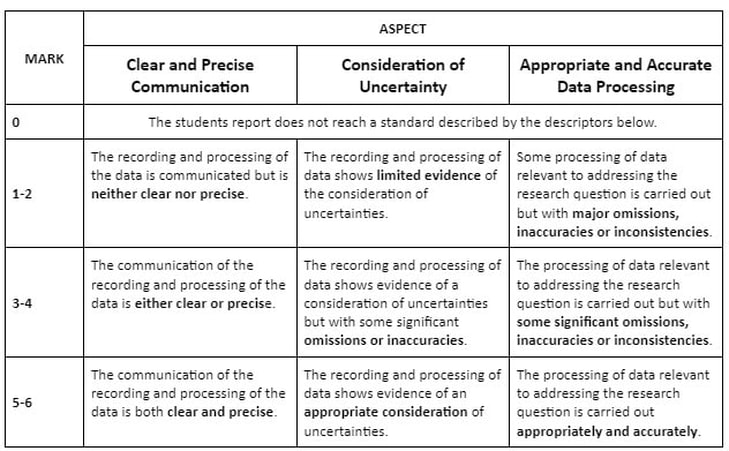Internal Assessment Analysis
This criterion assesses the extent to which the student’s report provides evidence that the student has recorded, processed and presented the data in ways that are relevant to the research question.
- Click for the summary of IB internal assessment requirements.
- Click for a printable score sheet
CLEAR AND PRECISE COMMUNICATION
Clear communication means that the method of processing can be understood easily. Precise communication refers to following conventions correctly, such as those relating to the annotation of graphs and tables or the use of units, decimal places and significant figures.
Clear Communication of Data
Check list:
Precise Communication of Data
Check list:
Clear communication means that the method of processing can be understood easily. Precise communication refers to following conventions correctly, such as those relating to the annotation of graphs and tables or the use of units, decimal places and significant figures.
Clear Communication of Data
Check list:
- Narrative text references figures and tables
- Graphs, tables and images included as close as possible to its first reference
- Raw data is clearly presented for the range of levels and number of repeats described in the methodology
- Data to show consistency of controlled variables is clearly presented
- Tables and graphs do not break across pages
- Insightful and thorough qualitative data is presented (maps, sketches, observations and/or photos with annotations)
- Clear explanation with justification for the descriptive analysis (central tendency and spread of data)
- Clear explanation with justification for the inferential analysis (statistical significance testing)
- Statistical test(s) include null and alternative hypothesis and probability levels (p values).
- Clear explanation with justification for the type of data visualization/graph, including use of trendlines
- All data, graphs and images are relevant to the research question
Precise Communication of Data
Check list:
- Graphs/tables/images are sequentially titled (i.e. “Figure 1…”)
- Metric measurement units are used
- Tables are well organized, with specific and clear titles, headings and units
- Data tables are well organized either by groups or types of data
- Table column headers are present and correct (MV in first column)
- Correct and consistent number of decimal places
- Correct number of significant digits
- Graph is well organized, with specific and clear title, labeled axis (with unit) and appropriately scaled axis
CONSIDERATION OF UNCERTAINTY
Measurement Uncertainty
Check list:
Variation within Raw Data
Check list:
Measurement Uncertainty
Check list:
- Correct uncertainty of all measuring device(s) reported for raw measurements
- Uncertainties of measuring device(s) justified and/or explained
- Uncertainty of measurement(s) indicated in the column header of the data table
- Discussion of the size of measurement uncertainties compared to the data collected
Variation within Raw Data
Check list:
- Variation within the data collected is described with reference to outliers, skew, standard deviation and/or interquartile range
- Variation within the data is visualized as error bars on the graph(s)
APPROPRIATE AND ACCURATE DATA PROCESSING
The rubric mentions major and significant omissions:
Appropriate Data Processing
Check list:
Accurate Data Processing
Check list:
The rubric mentions major and significant omissions:
- “Major omissions” = inaccuracies or inconsistencies impede the possibility of drawing a valid conclusion that addresses the research question.
- “Significant omissions” = inaccuracies or inconsistencies allow the possibility of drawing a conclusion that addresses the research question but with some limit to its validity or detail.
Appropriate Data Processing
Check list:
- Per trial calculations to determine RV, if necessary (i.e. rate or percent change)
- Skew or outlier analysis is performed, if relevant
- Appropriate measure of central tendency (mean, median, mode) is calculated, if relevant
- Appropriate measure of variation (SD, IQR, range) is calculated, if relevant
- Appropriate inferential test is performed, if relevant
- Correct conclusion of significance is drawn
- Appropriate type of graph is selected for data visualization
- Appropriate trendlines are added to the graph, if relevant
Accurate Data Processing
Check list:
- Per trial calculations to determine RV are mathematically correct, if relevant
- Skew or outlier analysis is mathematically correct, if relevant
- Measure of central tendency calculation is mathematically correct, if relevant
- Measure of variation calculation is mathematically correct, if relevant
- Inferential test calculation is mathematically correct, if relevant
- Formula, Excel formula, worked example or screenshot of calculations given
